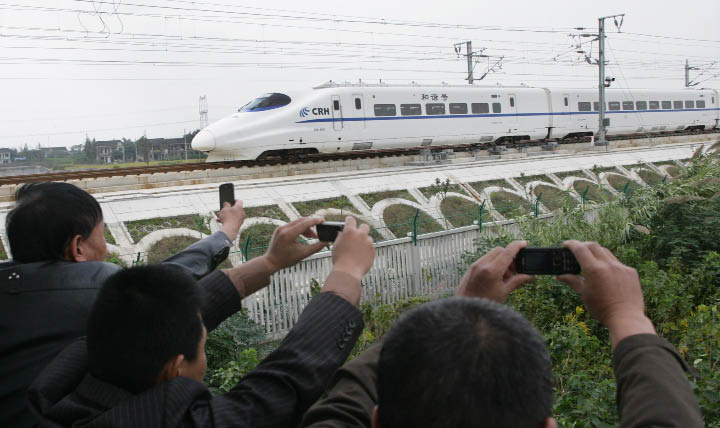| Dreams That Ride the Rails
A Jiashan Farmer’s Hopes
By special correspondent SONG BING
 |
| Local people recording the historic moment. |
IT’S October 25 and, as he stands in front of his new house clearing the last bit of mud off his shovel, Liu Aiguo, a farmer in his fifties, struggles with mixed feelings. On the one hand, building the new house has taken every penny of his savings plus a big loan from relatives; on the other, if he sells this house, the price will far exceed his investment, and the return could make him a millionaire.
These kinds of opportunities have become possible because of the construction of the Shanghai-Hangzhou High-Speed Railway just a few kilometers away.
A farmer from Jiashan County in Zhejiang Province, Liu has occupied his old house in Jiangjia Village for over a decade. As the route of the railway was unveiled, his house, just 50 meters from the track, was naturally placed into the demolition zone. Along the 11.5-km-long Jiashan section of the high-speed link over 300 households like Liu Aiguo’s were slated “for demolition and resettlement,” most of them local farmers.
Liu’s village is in Jiashan, ranked as one of China’s top 100 counties, but now seems something of a “poor relation” when compared with nearby cities and counties whose economic development has seen meteoric growth. But with the prospect of high-speed trains whistling by, Liu – indeed all of his village – spotted an unprecedented opportunity was heading their way.
In fact, Liu never thought of leaving his old house; the most he envisaged was building a few rooms on a nearby plot when his son married. But in March 2009 the arrival of a demolition and relocation notice from the county authorities forced a rethink.
According to the local government compensation agreement, Liu was entitled to 110,000 yuan compensation for demolition of his 370-square-meter home. In addition, the authorities offered a free plot on several hectares of land set aside for resettlement of people from Liu’s village and another one nearby. The families could erect their own houses there, but the construction expense had to be met by the families.
Within the New Farmers Community, built within eyeshot of the village, nearly 100 spanking new four-story buildings form neat ranks, making a sharp contrast with the older buildings that still remain here and there.
| 